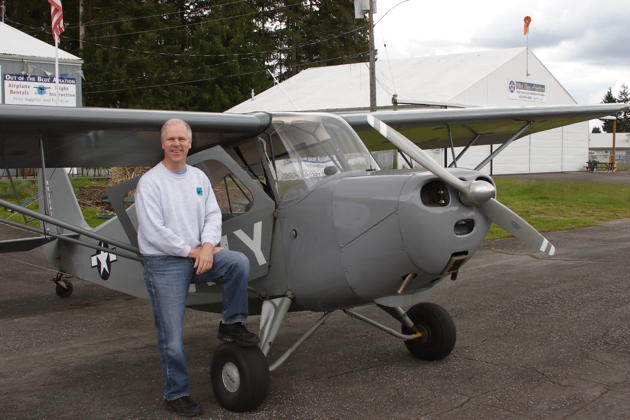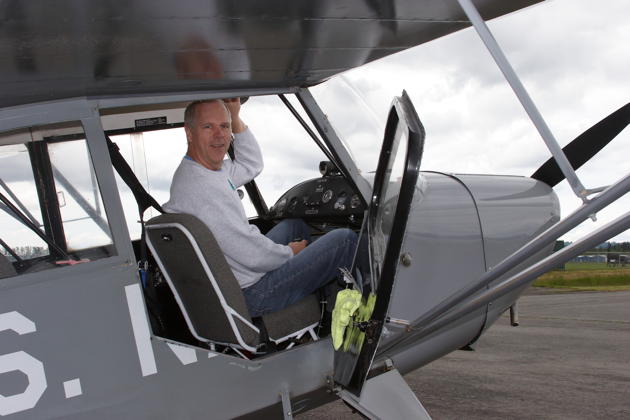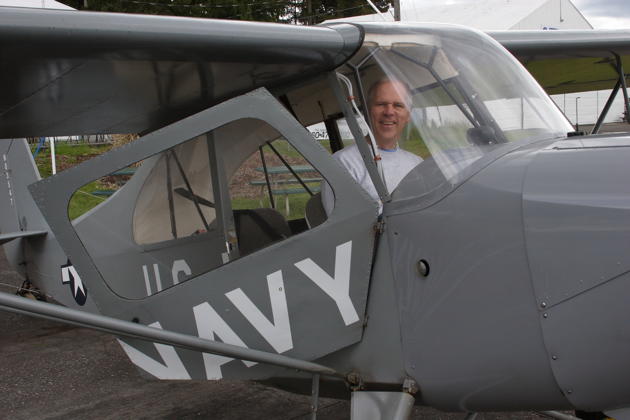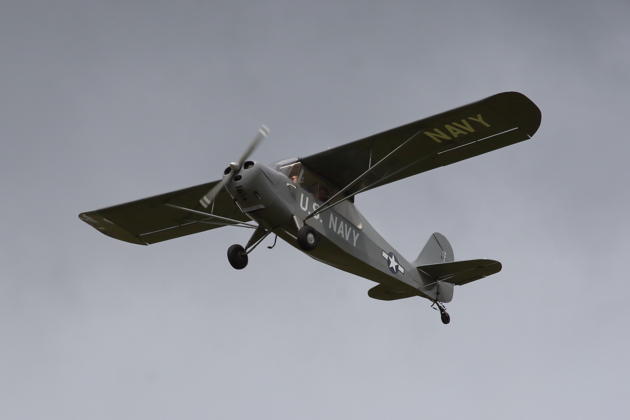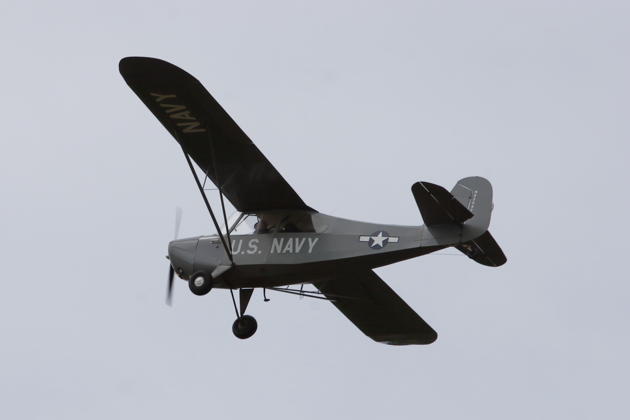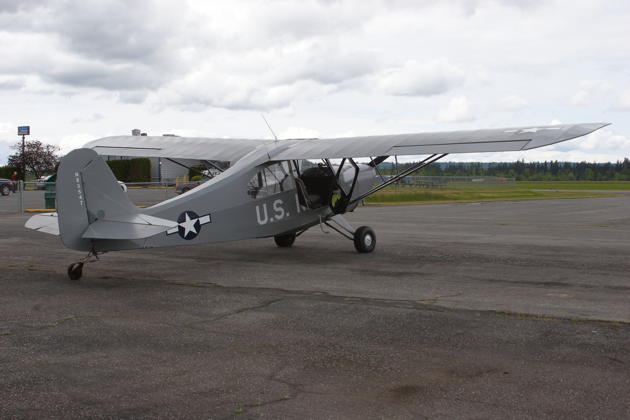FlightLog Archive
∟Aircraft Flown
Flying the Champ - May 2011
It was finally time to get my tailwheel endorsement, especially after very enjoyable flights in Stearmans, T-6/Harvards and other enjoyable warbirds and vintage aircraft. I discussed options for the best tailwheel aircraft to start with, and most pilots with extensive tailwheel experience suggested starting with a very simple aircraft, such as an Aeronca Champ or a Piper Cub.
I found an Aeronca Champ available at Out Of The Blue Aviation at the Arlington, WA airport, where I instructed monthly in sailplanes. Even better, one of my fellow soaring instructors, Ron Bellamy, also instructed in the Champ at Out Of The Blue. Ron and I planned to fly the Champ whenever possible in the early part of 2011. Unfortunately, every weekend we planned to fly turned out to be a weather bust from January through March in the Great 'Soggy' Northwest. Finally, starting in April, Ron and I were able to schedule some days with decent weather, aircraft and pilot availability.
My first flight in the Champ was on a glorious April day, after Ron and I spent time on a very thorough pre-flight and ground ops planning session. Our Champ, as most 7AC's, has no electrical system, and requires hand-propping to start. We did have a handheld radio for comm, and a lightweight but efficient intercom system between the cockpits. I was pleasantly surprised at the excellent over-the-nose visibility from the front seat, expecting poor visibility that would necessitate 'S-turns' while taxiing, but instead I had a decent view in the forward sector.
Ron and I had two follow-on flights in May, where I got a chance to exercise and practice the recommended maneuvers from FAR Section 61.31 for tailwheel checkout. Although we flew airwork covering coordination, stalls, slow flight, slips and turns around a point, the majority of our effort focused on the traffic pattern and landings. I was able to fly a large number of wheel landings, and got a good feel for the slight amount of cushioning throttle to add as we approached the runway, and the right amount of forward stick pressure once we touched down to keep the tail up while rolling out. As the elevator lost effectiveness, I learned the timing to bring the stick fully aft to plant the tailwheel on the ground. Ron and I discussed and practiced ground loop avoidance techniques throughout.
I tried some power off glides and also slips, which were surprisingly effective in controlling descent rate. I had a great time practicing three point landings, especially once we moved from the hard surface to the grass. Once I learned the sight picture and the correct stick inputs, I had a blast nailing the landings. After I covered all the recommended items from the excellent Tailwheel Endorsement Syllabus from Blue Sky Aero, Ron signed me off as a newly minted tailwheel driver. I really enjoyed flying the Champ, and look forward to continuing with more of her tailwheel relatives!
Theresa, David, Katie and Ma - thanks for the Christmas present!
Techniques and best speeds to fly: On departure, stick forward until about 45 MPH, which is when the aircraft starts feeling light, then apply aft stick, pitch to climb at full throttle (about 2150 RPM) at 55-60 MPH for the best climb angle. In the pattern, fly downwind at around 65-70 MPH, slowing in the base and final turns to around 50-55 MPH on final. When throttling back below 2000 RPM, turn on the carb heat, since the Champ's Continental 65 hp engine is quite prone to carburetor icing.
I recommend Damian DelGaizo's excellent Tailwheel: 101 DVD as a valuable study resource while preparing for a tailwheel endorsement. Damian provides good examples and techniques that were quite helpful in my transition to tailwheel flying.
Epilog
With the closing of Out of The Blue Aviation in February 2012 at Arlington, they have sold Champ N83547, which has been dismantled and moved to Philadelphia. Fly well in your new home!
Epilog 2
In July 2016, I received an update from Bob Curran, with a great update on his father's previous involvement with N83547, but also a sad ending to this Champ's career. In Bob's words:
"While reviewing my late father's pilot logbook last night I decided to search to see how many of the airplanes he flew were still flying today. That's how I stumbled upon your blog entry about N83547. My father took his primary flight lessons in a handful of 7AC Champs in San Diego, CA, in 1947 and 1948. One of them was N83547, which he flew once for 30 minutes on January 7, 1947. Though I'm sure she didn't look like she did in the photos on your blog."
"Of all the airplanes my dad flew during his primary training and after he earned his pilot's license, there is still one 7AC flying in Texas and one that appears to be undergoing a restoration in Wyoming. The rest have all had their tail number reassigned or are of unknown status. It has been an interesting experience going through his logbook and looking up the airplanes. I also found receipts for his rental of a 7AC just eleven days before I was born. He bought 1.9 gallons of fuel for $0.75. The rental fee for the airplane was $1.00 for 30 minutes."
"Alas, it seems N83547 has likely made her final flight on June 1, 2016."
On June 1, 2016, about 0900 eastern daylight time, an Aeronca 7AC, N83547, was substantially damaged after impacting an aircraft hangar following a total loss of engine power during a go-around at New Garden Airport (N57), Toughkenamon, PA. The flight instructor and a student pilot received minor injuries. Police say the plane went into the hangar, passing between two other parked planes before coming to rest inside the structure. Neither of the other planes was damaged, and no one inside the hangar was hurt.
Farewell to a fine taildragger with a long history!
 KASPRZYK
KASPRZYK
